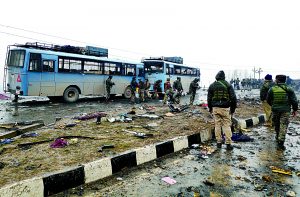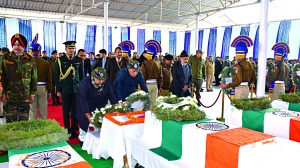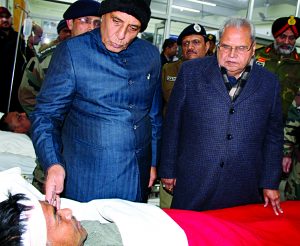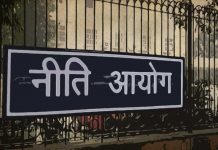 India’s military strike against Pakistan in response to Pulwama attack which killed more than 40 CRPF personnel and the Pakistani response to it has brought the region to the brink. The crisis began on Tuesday when India launched a pre-dawn attack on Jaish-e-Muhammad headquarters at Balakote in Khyber Pakhtunkhwa. New Delhi termed its attack on Pakistan as “non-military preventive strike on a major Jaish-e-Mohammed terror camp”. In a statement released soon after the attack, Foreign Secretary Vijay K Gokhale said: “the Government of India is firmly and resolutely committed to taking all necessary measures to fight the menace of terrorism”.
India’s military strike against Pakistan in response to Pulwama attack which killed more than 40 CRPF personnel and the Pakistani response to it has brought the region to the brink. The crisis began on Tuesday when India launched a pre-dawn attack on Jaish-e-Muhammad headquarters at Balakote in Khyber Pakhtunkhwa. New Delhi termed its attack on Pakistan as “non-military preventive strike on a major Jaish-e-Mohammed terror camp”. In a statement released soon after the attack, Foreign Secretary Vijay K Gokhale said: “the Government of India is firmly and resolutely committed to taking all necessary measures to fight the menace of terrorism”.
A day after Pakistan violated Indian airspace in Rajouri sector of J&K, dropping a few bombs. Pakistan also claimed to have shot down two Indian aircrafts inside Pakistan Administered Kashmir and capturing the Indian pilot Abhinadan Vardhman. India said it has also shot down a Pakistani F-16 which fell in Pakistani territory. Now should India choose to respond again, things could go up the escalatory ladder and culminate into a full-fledged war.
However, in a speech after Pakistani action Pakistan Prime Minister Imran Khan sought to de-escalate the situation and offered India dialogue and assurance to act if provided with a proof of Pakistani involvement.
But while the two countries are at it, the situation in Kashmir, the site of the attack against the CRPF, has been pushed into the background. When on February 14, a Kashmiri suicide bomber Adil Ahmad Dar rammed his explosive-laden vehicle into CRPF convoy, it was unlike any other incident of violence Kashmir had witnessed in the three decades of militancy. And yet it was seen as organic to the violent situation that has been prevailing in the state over the past five years – Pakistan dimension, notwithstanding.
 Adil Ahmad Dar was the product of this situation. He lived just ten kilometres away from the site of bombing. Seven months before he was just an ordinary worker at the sawmill of his neighbour. But then, as has become the norm in Kashmir, he left home one morning and didn’t return. The family filed a missing report with the police but to no avail. A month later Dar’s picture showing him wielding a Kalashankov and as a member of the Jaish-e-Muhammad hit the social media. On seeing it, father Ghulam Ahmad Dar said to his wife: “forget about him, he is now a dead man”.
Adil Ahmad Dar was the product of this situation. He lived just ten kilometres away from the site of bombing. Seven months before he was just an ordinary worker at the sawmill of his neighbour. But then, as has become the norm in Kashmir, he left home one morning and didn’t return. The family filed a missing report with the police but to no avail. A month later Dar’s picture showing him wielding a Kalashankov and as a member of the Jaish-e-Muhammad hit the social media. On seeing it, father Ghulam Ahmad Dar said to his wife: “forget about him, he is now a dead man”.
Unknown to family, Dar over the past many months was being trained as a “fidayee”, an Urdu name for a suicide attacker. And before launching the attack, he duly shot a video to explain the rationale for it. Soon after the bombing, the video was posted on social media and it soon went viral.
Two days later, the forces killed three Jaish militants, two of them Pakistanis, at a nearby Pinglina, saying they were the masterminds of Pulwama bombing. Four soldiers including a major, one police man and a civilian were also killed in the operation.
With Jaish openly owning the attack, the government blamed Pakistan for organizing it and spoke of revenge. The dominant political and media discourse soon veered to the option of military response to Pakistan. Prime Minister Narendra Modi too left no one in doubt on this score. He warned the perpetrators and their supporters that “every drop of tear will be avenged”. In response Pakistan Prime Minister Imran Khan also made it clear that his country will not think before retaliating to any Indian attack. The subsequent attacks and counter-attacks are seeing the two countries staring at a fresh crisis.
 Though Islamabad has vehemently denied that it is involved in the attack, the ownership of the bombing by the Jaish which is based in Pakistani Punjab has put the neighbour in the dock. The timing of the attack is also significant. It was carried out in the run up to the general elections. This has left analysts puzzled as to whether the deadly strike was also intended to influence the course of the elections or draw New Delhi into a conflict with Pakistan.
Though Islamabad has vehemently denied that it is involved in the attack, the ownership of the bombing by the Jaish which is based in Pakistani Punjab has put the neighbour in the dock. The timing of the attack is also significant. It was carried out in the run up to the general elections. This has left analysts puzzled as to whether the deadly strike was also intended to influence the course of the elections or draw New Delhi into a conflict with Pakistan.
“This is all in the realm of speculation. But setting aside the potential conflict between India and Pakistan whose chances are very slim, Pulwama attack will definitely influence the general elections,” says the political analyst Gull Mohammad Wani. “The attack has disrupted the development and corruption-centric election discourse that was building up so far. In its place, security, Kashmir and Pakistan have hurtled to the centre stage. Let us see who seizes the narrative on these issues”.
But Wani believes that Modi with his hardline stance on Pakistan and Kashmir could still carry the day. “BJP has so far deftly managed to shift the focus of the debate on Pulwama attack away from the failure of its Kashmir policy to Pakistan. It has also used the attack to further harden its policy and the potential action. It is to be seen how opposition spotlights government’s own failure in J&K”.
However, influencing the upcoming election is not the only major fallouts of the Pulwama bombing and the subsequent events: they will cast a long shadow on Indo-Pak relations and also determine the centre’s future approach to the worsening situation in Kashmir.
“Also, Pulwama is also going to be a factor in how world looks at the situation in Kashmir,” says Wani. “But while the world condemns the growing violence in Kashmir, it will also be worried about the turn the situation is taking in the state and its implications for the regional peace”.
India-Pakistan ties
The attack has plunged India-Pakistan relations to their lowest low. India has taken a series of steps to punish Pakistan apart from the military strikes. It has withdrawn the Most Favoured Nation status unilaterally granted to the neighbour. Also, the tariff on Pakistan’s exports to India has been raised up to 200 percent. It has also decided to stop its share of water to the country under Indus Water Treaty. India will also renew its efforts to isolate Pakistan at the international level.Prime Minister Narendra Modi has also said that the time for talks with Islamabad is over now.
The military strikes against Jaish camp and the response from Pakistan is certain to take the situation to an entirely new level. It has threatened to push the region over the brink. After Pulwama, the PM Modi was constrained to go one up on the surgical strikes. And there were reasons for it: Indian army’s bombing of militant launchpads in 2016 not only was denied by Pakistan but it has had little impact on the situation on the border or inside Kashmir. Besides, high-profile attacks on the security targets have continued unhindered. So much so, the number of security personnel killed over the past five years is 488 which makes the ratio of killings of security personnel and the militants in the state as 1:2.
So, any fresh military action against Pakistan had to be bigger and visible, one that satisfied the enraged public and also inflicted a deterrent blow on Pakistan Army. But this calculation seems to have gone awry, as Pakistan has chosen to respond. Situation if not contained could trigger a war.
“And the continuing escalatory spiral could end up into a full-fledged war and a possible breach of the nuclear threshold of the either country,” an editorial in Kashmir Observer says. “This is a doomsday scenario that alarms the world and should also deeply concern the people of the region”.
However, whether the war comes through or not, the Pulwama bombing has delivered a crushing blow to any hope of the resumption of India-Pakistan dialogue after the elections.
“Mumbai attack in 2008 derailed a promising India-Pakistan dialogue which had almost culminated into a peaceful resolution of Kashmir. Ever since the two countries have struggled to get back to engagement,” says the political commentator Gowhar Geelani. “Now Pulwama attack and the India-Pak confrontation is likely to make it further difficult for the two countries to resume talks. That is, unless both recognize that the only way to peace is to engage and resolve the issues breeding violence and instability”.
Elephant in the room
Kashmir has largely been absent from the political and media narrative generated by the Pulwama attack. The state has only been in news for the attacks on Kashmiri students and traders in other parts of the country. The narrative has so much been Pakistan and terrorism-centric that the hard questions about the attack itself and its place of occurrence have been quietly ignored. Intelligence failure aside, the attack was carried out by a 20 year old Kashmiri youth. Though, it is not the first suicide attack by a Kashmiri it is the most devastating of them all. In past, only a few Kashmiris have resorted to fidayeen strikes. Suicide attacks in Kashmir have generally been carried by the foreign militants belonging to Lashkar or Jaish.
But Pulwama has now confirmed that Kashmiri militants may have completed the right of passage. While Jaish may have provided logistics, it was a local youth bred in the local sentiment and a sense of cause that carried it out. And should this trend catch on, it could turn Kashmir into a far bigger battleground than it is now.
“This is the real concern in Kashmir. But this is a concern that is absent from the national discourse,” says PDP spokesman and former J&K education minister Naeem Akhtar. “There is little discussion on why and how Kashmir reached a stage where a youth is ready to turn his body into a bomb”.
True, Kashmir has transformed over the past five years, the duration of the BJP-led government at the centre and its coalition with the PDP in J&K. The period has witnessed the rise of the new age militancy which witnessed local youth taking a shine to militancy after more than a decade of dwindling local representation. In fact by 2015, for the first time in a decade, the local militants outnumbered the foreigners in Kashmir. Out of 142 active militants in Valley, 88 were locals and the rest from Pakistan or Pakistan Occupied Kashmir. Similarly in 2016 the militant figures revealed by the government put the number of local militants at 91 and the foreigners at 54 out of a total of 145.
“The question that needs to be asked is what is it that fundamentally changed in Kashmir for the local youth to resort to militancy,” asks Geelani. “But that it started immediately after the BJP took power at the centre is clear enough an answer”.
BJP’s Kashmir policy
 The BJP is blamed for drastically altering the way New Delhi looked at Kashmir. It unveiled a hardline policy outlook informed by its long held ideological position on the state. The policy had a psychological, political and militaristic impact on the state.
The BJP is blamed for drastically altering the way New Delhi looked at Kashmir. It unveiled a hardline policy outlook informed by its long held ideological position on the state. The policy had a psychological, political and militaristic impact on the state.
On a psychological level, the Modi government played on Kashmir’s worst fears by opening a prospect for a demographic change through contemplated withdrawal of the Article 35A of the constitution that forbids outsiders from settling in the state. Six petitions are challenging the validity of the Article 35A in the Supreme Court. And every time there is a hearing, Kashmir turns deeply anxious about the outcome and observes a shutdown.
Politically, the majority community in the state has perceived an attempt at marginalizing its role in the political setup of the state. While in the previous PDP-BJP coalition, the BJP deepened this perception by largely setting the agenda for the state government, the current J&K Governor Satya Pal Malik is perceived to be implementing the BJP’s longstanding agenda on the state. Ever since Malik’s appointment he has been on a frenetic lawmaking spree, even passing the contentious orders which ideally should only have been issued by an elected government after a proper deliberation.
One such order is the recent grant of division status to Ladakh, earlier a part of Kashmir Valley. Though the demand for the division status for Ladakh is a long-standing one but so is the one from Pir Panjal and Chenab Valley regions of the Jammu province. But while the administration ignored the latter’s demand, it addressed the one from Ladakh without taking the state’s political opinion on board. The State Administrative Council also issued the order with little prior indication of the move.
So problematic is the move seen in the state that the PDP leader and the former J&K Chief Minister Mehbooba Mufti took a serious exception to what she termed a selective decision.
“You (Centre) are trying to break the Muslim majority character of the state. We will not let it happen. Its consequences would be very dangerous,” she said at a press meet in Srinagar immediately after the division status to Ladakh. “We want to tell, not only to the Governor but also the Government of India, that you are playing with fire. You want to disempower the Muslims of Jammu and Kashmir; you want to divide them into separate compartments, into Shia-Sunni, into Kashmiri-Punjabi, into Gujjar and Pahari”.
However, it is New Delhi’s hard militaristic response to the situation that has caused the most anger and alienation in Kashmir and brought it to tipping point of the kind marked by the Pulwama attack. According to South Asia Terrorism Portal, more than 1500 people — civilians, security forces and militants — have been killed in violence in the state from 2014 onwards. But 586 of them — 160 civilians, 267 suspected militants and 159 security force personnel – were killed in 2018.
It is also in this period that Kashmir witnessed 2016 mass unrest following the killing of the then Hizbul Mujahedeen commander Burhan Wani which led to death of around a 100 protesters and a partial or complete blinding of several hundred. Forces indiscriminately used the pellet guns to tackle the angry crowds. The killings and the blindings, in turn, have left a massive humanitarian fallout in their wake. And this, in turn, has deepened alienation and stoked anger against New Delhi, forcing local youth to flock to militancy.
“The truth is that over the past four years Kashmir Valley has been groaning under a no-holds-barred militaristic policy that is designed to kill the way to peace in Kashmir. This has involved the killing of not only the militants but also a harsh response to public protests,” says Naseer Ahmad, a local columnist. “The use of the pellet guns has been encouraged leading to partial or complete blinding of hundreds of Kashmiris. And while this has caused untold sufferings, the media, security and the political discourse in the country has chosen to celebrate it. The toxic television anchors have used Kashmiri blood and suffering to raise their TRPs. The conflict has thus led to brutalization of the people on both sides”.
Where do we go from here
The situation as of now is very uncertain. Whatever form the tit for tat attacks takes between India and Pakistan, situation looks set to get a lot worse before it improves. India, Pakistan dialogue now looks farther than ever unless something dramatically changes for the better between the countries. But a dialogue geared towards addressing the underlying cause of tension between the two countries and the violence in Kashmir is what is essentially needed for a durable peace in the region, says the noted J&K historian Siddiq Wahid in a piece. “Lost in all the noise and silenced in its wake is any discourse on how South Asia reached this point and, more critically, what we are to do about it. All that is heard is demonisation of Kashmiris and calls for crushing Pakistan.” At the risk of sounding clichéd, even trite, the importance of initiating a dialogue on the Kashmir conflict is as critical as its absence is dangerous”.












